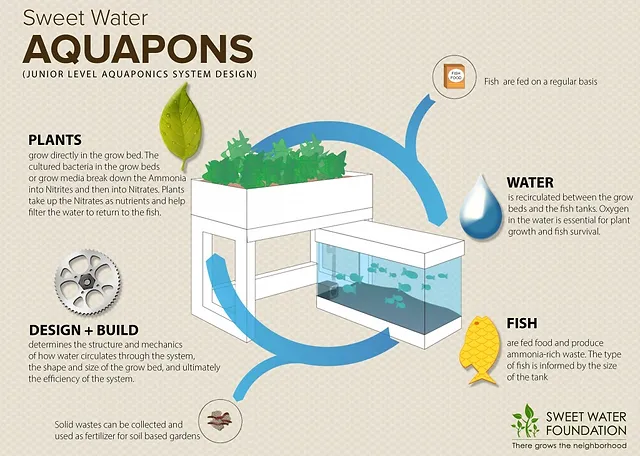Aquaponics 101 is an innovative and sustainable method of food production that combines aquaculture (fish farming) with hydroponics (soilless plant cultivation). This system creates a symbiotic environment where fish and plants support each other, leading to efficient resource use and environmentally friendly farming. This article explores the basics of aquaponics, its benefits, and how to set up your own system.

Aquaponics 101
Understanding Aquaponics
- The Basic Concept Aquaponics relies on a closed-loop system where fish waste provides essential nutrients for plant growth, and plants, in turn, filter and clean the water for the fish. This mutual relationship creates a balanced ecosystem that can produce both fish and plants simultaneously.
- Components of an Aquaponics System An aquaponics system consists of several key components: a fish tank, a grow bed for plants, a water pump, and a filtration system. The fish tank houses the fish, whose waste is converted by beneficial bacteria into nutrients that plants can absorb. The grow bed supports the plants, which filter the water before it is recirculated back to the fish tank.
- Types of Aquaponics Systems There are three main types of aquaponics systems: media-based, nutrient film technique (NFT), and deep water culture (DWC). Media-based systems use a growing medium, such as gravel or clay pellets, to support plants. NFT systems circulate water through channels, where plant roots absorb nutrients directly. DWC systems float plants on rafts in nutrient-rich water.
Benefits of Aquaponics
- Sustainability Aquaponics is a sustainable farming method that minimizes water usage compared to traditional agriculture. The closed-loop system recirculates water, reducing the need for constant irrigation. Additionally, aquaponics does not require synthetic fertilizers or pesticides, making it an eco-friendly option.
- Resource Efficiency By combining fish farming and plant cultivation, aquaponics maximizes resource efficiency. Fish waste, which would otherwise be a pollutant, becomes a valuable nutrient source for plants. This reduces the environmental impact of both aquaculture and agriculture.
- Year-Round Production Aquaponics systems can be set up indoors or in controlled environments, allowing for year-round food production regardless of external weather conditions. This continuous production cycle ensures a steady supply of fresh fish and vegetables.
Setting Up Your Aquaponics System
- Choosing the Right Fish Select fish species that are well-suited to your local climate and aquaponics system. Tilapia, trout, and catfish are popular choices due to their adaptability and fast growth rates. Ensure the fish you choose are compatible with the plants you intend to grow.
- Selecting Plants Leafy greens, herbs, and certain vegetables thrive in aquaponics systems. Lettuce, basil, spinach, and tomatoes are common choices. Consider the light, temperature, and nutrient requirements of the plants when planning your system.
- System Maintenance Regular maintenance is essential to keep your aquaponics system functioning smoothly. Monitor water quality parameters, such as pH, ammonia, nitrate, and nitrite levels, to ensure a healthy environment for fish and plants. Perform routine checks on the water pump and filtration system to prevent malfunctions.
Challenges and Solutions
- Initial Setup Costs While aquaponics can save money in the long run, the initial setup can be costly. Investing in quality equipment and components will pay off over time. DIY options and small-scale systems are also available for those on a budget.
- Balancing Nutrients Maintaining the right nutrient balance is crucial for the health of both fish and plants. Regular water testing and adjustments to feeding and planting schedules can help achieve this balance.
- Pest Management Although aquaponics reduces the need for pesticides, pests can still be a problem. Introducing beneficial insects, such as ladybugs, and implementing physical barriers can help manage pests without harming the ecosystem.
Conclusion
In conclusion, aquaponics 101 offers a sustainable and efficient solution for producing fish and plants in a symbiotic environment. By understanding the basics of aquaponics, its benefits, and how to set up and maintain a system, you can enjoy fresh, homegrown produce and fish while contributing to a more sustainable food system. As interest in eco-friendly farming methods grows, aquaponics stands out as a promising approach to meet future food production needs.


